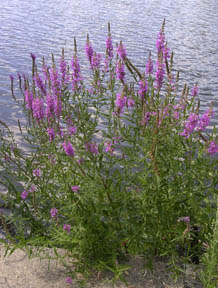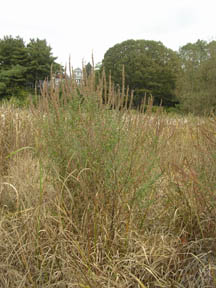Fresh
Pond Reservation
Purple Loosestrife Biocontrol Project
Initiated November 4, 2006
A Collaboration
between
The Cambridge Water Department
and Friends of Fresh Pond Reservation
The Plant…and the Problem
Purple Loosestrife, (Lythrum salicaria) is a beautiful flowering plant that was brought to North America from Europe in the 19th century. It has become invasive in wetlands across much of the continent, replacing native wetland species such as the common cattail, and diminishing habitat for birds and other animals.
Because purple loosestrife arrived here without any of the natural insect predators and diseases that would reduce its vigor, this long-lived perennial is able to outgrow other species. It sprouts early in the spring, grows up to 7 feet tall, and produces as many as 3 million seeds per plant.
 |
 |
|
Purple
loosestrife in flower and in seed © 2006 E.
Wylde
|
Purple loosestrife was not considered a problem at Fresh Pond Reservation until a few years ago. Now it has spread to all wet areas of the Reservation including the perimeter of Fresh Pond. (See MAP.) As efforts have been made to restore natural habitats and to create wetlands that serve as natural filters for storm water runoff, it has become clear that purple loosestrife will have a negative impact on biodiversity and, ultimately, on water quality.
Initial efforts
at eradication included cutting, digging, and the application of herbicides.
Cutting was found to stimulate branching and the production of even
more flowers, digging proved to be extremely difficult, and the use
of herbicides near a drinking water reservoir is considered problematic
because of the possibility of contamination of the water.